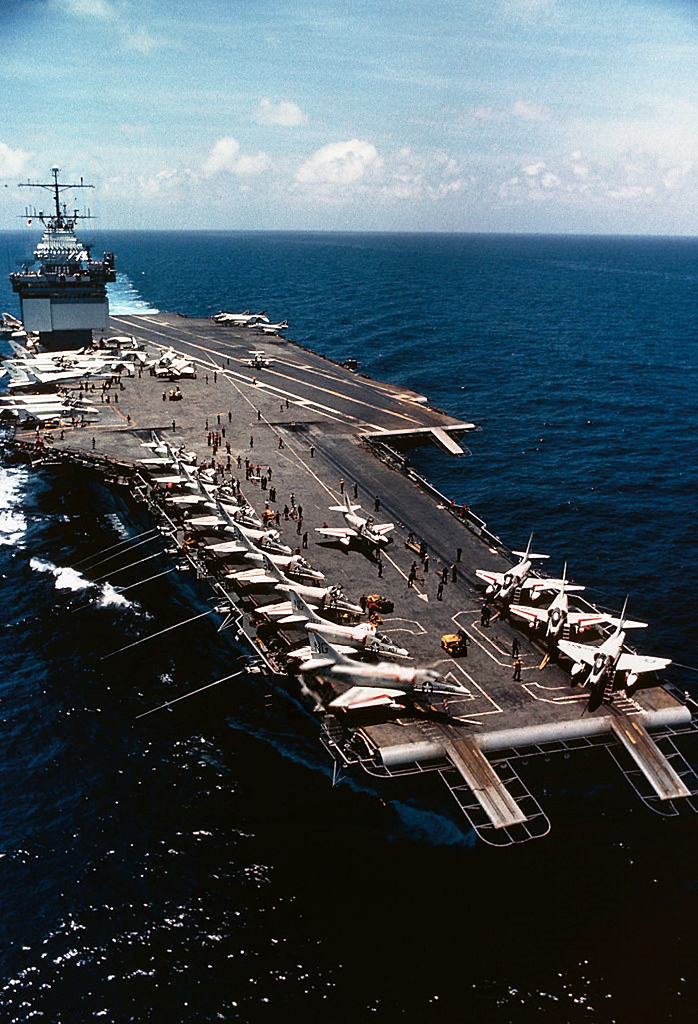
From the moment the USS Enterprise, the world’s first nuclear-powered aircraft carrier, was launched in 1961, the landscape of naval warfare was forever altered.

The Enterprise, also known as CVN-65, exemplified the shift towards a new era where air power could be projected globally, unfettered by the limitations of traditional fueling needs.

Her ability to stay at sea indefinitely without refueling presented not only a technical marvel but also a clear manifestation of the U.S. military’s strategic objectives.

The USS Enterprise and her nuclear-powered successors marked a watershed moment in naval operations. The unique feature of an aircraft carrier is its capability as a mobile airfield, theoretically stationable atop the vast oceanic expanse, offering an airbase’s utility without the fixed location’s vulnerability. This mobility aligned seamlessly with America’s expansive foreign policy, catering to a hyperactive stance on global intervention.

The Enterprise’s storied service career stretched from the Cuban Missile Crisis to post-9/11 operations, illustrating its central role across multiple decades of conflict.

It was commissioned in 1961, just in time to join the blockade during the Cuban Missile Crisis—a move that played a significant part in preventing the delivery of Soviet nuclear missiles to Cuba and deescalating what could have spiraled into a nuclear war.

Four decades later, the Enterprise displayed its enduring relevance by responding to the 9/11 attacks, turning around en route home from the Persian Gulf to run sorties against al-Qaeda and Taliban targets in Afghanistan. By the time of her decommissioning in December 2012, Enterprise had seen a half-century of service, leaving a legacy of resilience and versatility.

While the iconic Enterprise has been out of service for over a decade, the significance of aircraft carriers within the U.S. Navy has only grown. The world’s most advanced and formidable aircraft carriers continue to serve as symbols of national prestige and military might.

The USS Gerald R Ford Class, for instance, has raised the bar higher, setting new benchmarks in naval warfare with cutting-edge technology and a massive scale that dwarfs all predecessors.

The strategic importance of these vessels is not lost on global powers. Nations like the United Kingdom has invested heavily in their own aircraft carriers, with the Queen Elizabeth Class as testaments to their naval ambitions.

These modern carriers are equipped with the latest technological advancements, offering a clear statement of the UK’s determination to secure a dominant position on the world’s seas.

Yet, as we look to the future, new challenges emerge, particularly in the realm of decommissioning these technological titans. The unprecedented dismantling of CVN-65, a process only set to begin in 2025, foreshadows a complex and potentially costly endeavor.

The Navy’s innovative decision to enlist commercial industry, rather than its own shipyards, for the dismantling reflects a pragmatic approach that aims to save millions of dollars and crucial dock space, setting a precedent for the disposal of nuclear-powered carriers to come.

Aircraft carriers, from the Enterprise to the Gerald R Ford Class, have not only redefined the concept of naval superiority but also illustrate the evolution of military strategy and the continuous cycle of technological innovation.

Their legacy—from the strategic advantages they confer to the complex challenges they present in their twilight years—continues to influence the very nature of global naval power.
Relevant articles:
– USS Enterprise (CVN-65) Might Be the U.S. Navy’s Best Aircraft Carrier Ever, The National Interest
– 15 Best Aircraft Carriers in the World, ssbcrack.com
– USS Enterprise: Why CV-6 Is the U.S. Navy’s Best Aircraft Carrier Ever, The National Interest
– Uncharted waters: Navy navigating first, Breaking Defense

